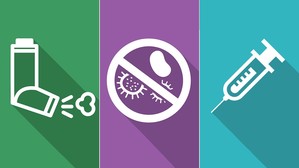 National Influenza Vaccination Week
December 3-9, 2017
U.S. CDC established National Influenza Vaccination Week (NIVW) in 2005 to highlight the importance of continuing flu vaccination through the holiday season and beyond.
Flu vaccination coverage estimates from past seasons have shown that few people get vaccinated against influenza after the end of November.
U.S. CDC
recommends that flu vaccination efforts continue throughout the flu season.
While the sooner you get vaccinated the more likely you are to be protected
against the flu when activity picks up in your community, vaccination into
December and beyond can be beneficial during most flu seasons.
For more information, please visit:
https://www.cdc.gov/flu/resource-center/nivw/index.htm

Influenza or “the flu” can be more serious for persons with asthma than for persons who do not have asthma. People with asthma are not more likely to get the flu, but flu symptoms can be more serious for people with asthma, even if their asthma is mild or their symptoms are well-controlled. This is because people with asthma have swollen and sensitive airways and the flu can cause further inflammation of the airways and lungs. Influenza infection can trigger asthma attacks and worsen asthma symptoms. It can also lead to pneumonia and other acute respiratory diseases.
Asthma is the most common medical condition among children hospitalized with the flu. It is also one of the more common medical conditions among hospitalized adults. In fact, adults and children with asthma are more likely to develop pneumonia after being sick with the flu than people who do not have asthma. Peak flu season months in the U.S. are December, January and February. Getting a flu shot is one way a person with asthma can stay healthy during flu season.
For your asthma patients:
-
Everyone with asthma who is 6 months and older should get a flu vaccine: To find out which flu vaccine is right for your patients visit the cdc.gov/flu/asthma.
-
Encourage patients with asthma to take every day preventive actions to stop the spread of the flu: Stay home when sick, except to get medical care. Stay away from other people who are sick. Cover the nose and mouth with a tissue when coughing or sneezing and throw the tissue away. Cough or sneeze into the elbow or shoulder. Wash hands often with soap and water, especially after coughing or sneezing. Clean/disinfect frequently touched surfaces at home, work or school, especially when someone is ill.
-
Update patients’ written Asthma Action Plan and ensure patients understand it
-
The U.S. CDC recommends that people with asthma not use zanamivir (Relenza®), an antiviral drug, because there is a risk it may cause wheezing in people that already have asthma or other lung problems.
Thank you all for your hard work and dedication. Vaccine wastage for the State of Maine has decreased by 64%
since last year because of your efforts. Keep up the great work! January 1, 2018 will mark a new year for the Replacement Procedure and all
providers will start the year off with 0% wastage. The new wastage threshold
will be sent out around February 2018. The 5% wastage threshold for each
provider will be based on their vaccine distribution in 2016 and 2017. If you have any questions regarding the Vaccine Replacement Procedure
please contact Valerie MacKenzie at valerie.mackenzie@maine.gov.
|
It is anticipated that the pediatric Hepatitis B vaccine will be unavailable until early 2018.
In light of the shortage, we would like to remind you that although the Recombivax® and Engerix® vaccine's antigen content
differs, the two different hepatitis B vaccines are interchangeable and a
series started with one brand of hepatitis B vaccine may be completed with the
other (using an age-appropriate dose and formulation) with one exception.
The exception to this is for the
two-dose schedule for adolescents aged 11 through 15 years -- only Merck
vaccine (Recombivax HB®) is approved for this schedule.
 It’s natural for parents to have questions about their child’s vaccines. The link below highlights answers to common questions about vaccine safety, the recommended schedule, how vaccines protect children from 14 diseases by age two, and more. U.S. CDC regularly updates this document to ensure frequently asked questions from parents are answered with the most current information.
https://www.cdc.gov/vaccines/parents/parent-questions.html
New patient handout for 16-year-olds —"You're 16 . . . we recommend these vaccines for you!" from the Immunization Action Coalition (IAC) and the Society for Adolescent Health and Medicine.


As of January 1, 2018, all devices in use, including back-up devices, must be a continuous monitoring and recording device that meets VFC Program requirements.
To meet VFC Program requirements, the device must be equipped
with:
- Active temperature display that can be easily read from the
outside of the unit
- Capacity for continuous monitoring and recording capabilities
where the data can be routinely downloaded
- Alarm for out-of range temperatures
- Current, minimum, and maximum temperatures display
- Low battery indicator
- Accuracy of +/- 1°F (0.5°C)
- Memory storage of at least 4,000 readings
- User programmable logging interval (or reading rate) recommended at a
maximum time interval of every 30 minutes
- A probe that best reflects the temperature of the vaccine (such
as a buffered probe)
|
 On November 15th, Dr. Paul Offit from the Children's Hospital of Philadelphia presented on new vaccine topics, which included:
- Shingrix® vs. Zostavax®
- Hepatitis B vaccine: Updates
- Mumps: What to do about the increased rates
- Influenza vaccine: Will FluMist® return?
To view a recording of the webinar, please visit: https://event.webcasts.com/viewer/event.jsp?ei=1161724
|
|